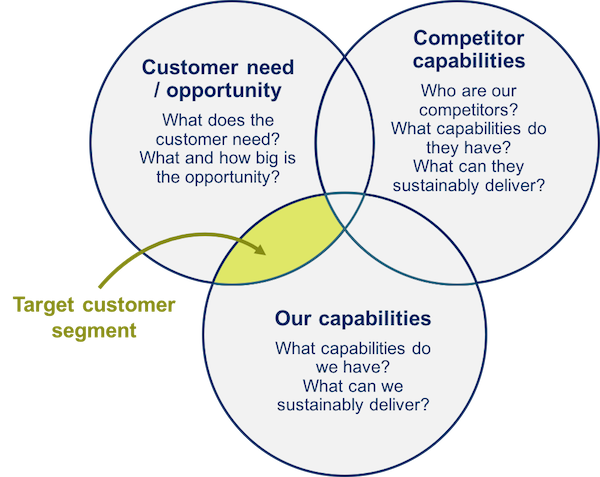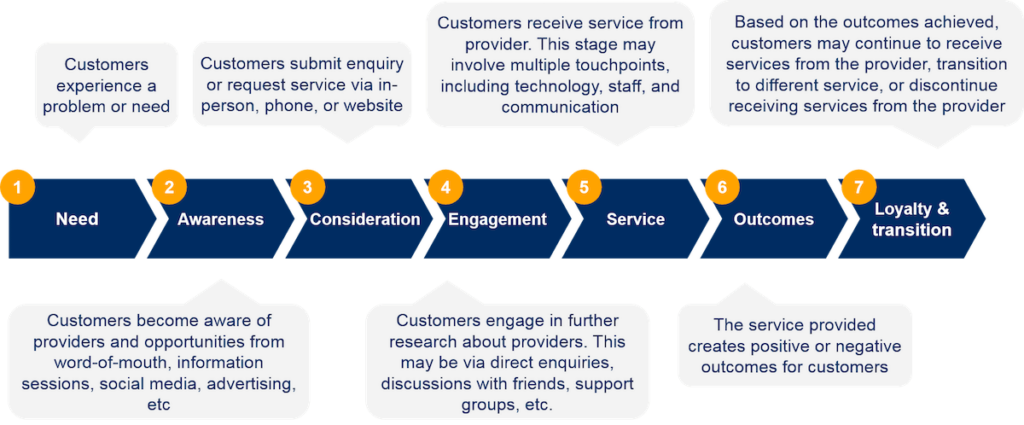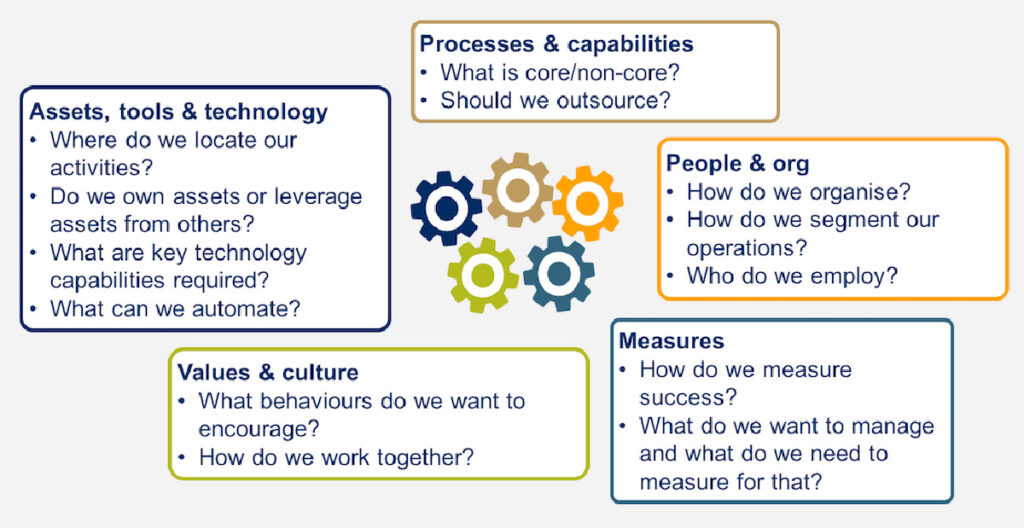
How disability service providers can become more customer-centric
A practical guide for providers looking to be more effective and efficient in supporting customers.

The introduction of the National Disability Insurance Scheme (NDIS) has catalysed a fundamental shift in disability services. Providers are facing more pressure to transform than ever before. With the switch from block to consumer-directed funding, individuals – whether people with disability or their families and carers – are newly empowered with choice. And they are exercising their choice. The 2017 NDS State of the Sector reports that 69% of disability service providers saw customers move on in 2017, a massive 35% increase from 2016.[1]
To survive, disability service providers are increasingly recognising they need to be customer-centric. In short, they need to be more effective and efficient at engaging and being relevant to customers – not only to ensure competitiveness and long-term financial sustainability but also to create real choice and control for people with disability.
Relevance for other human services sectors
As seen in the recent Productivity Commission report, ‘Introducing Competition and Informed User Choice into Human Services,’ the shift to consumer-directed funding in the disability sector parallels moves the government is making in the delivery of other social services. While we focus on NDIS and disability services providers in this article, similar changes and challenges will confront many other areas of human services.
This article unpacks what is meant by customer-centricity, and provides a guide and practical tips for organisations looking to take a customer-centric approach to transforming their operating model.
In the article, we use the term ‘customer’ to refer to people with disability and their families or carers. We recognise that this may seem an overly commercial term, however we intentionally use it to underline the new role of individuals as the purchasers of services, rather than government being the purchaser.
How does customer-centricity intersect with co-design or human-centred design? They all stem from a similar philosophy – incorporate the perspective of the person who uses the product or service. However, the difference is that most co-design and human-centred design projects are one-off and stop at the program or service. (This is typically due to how these projects are designed rather than being the fault of co-design or human centred-design as methodologies).
In our view, building a customer-centric organisation requires taking the customer perspective into the very architecture of an organisation, including its structure, processes, and measures, and embedding a loop of continuous feedback and improvement, not just creating a one-off design.
Customer-centricity – an overview
Ranjay Gulati, a professor at Harvard Business School, defines customer-centricity as ‘looking at an enterprise from the outside-in rather than the inside-out — that is, through the lens of the customer rather than the producer. It’s about understanding what problems customers face in their lives and then providing mutually advantageous solutions.[2]
Put another way, it is about shifting an organisation’s primary lens from what services it provides (e.g. assistance with daily living tasks) to who its target customers are and what they are trying to solve for (e.g. young adults looking to live on their own and become more independent).
While the concept may sound simple, the implications are profound. For instance, taking the above example, to help a person with disability not just maintain their state but become independent, organisations may want to:
- Hire for and train people to be coaches rather than caretakers
- Develop a new risk framework that not only permits but also encourages calculated risks
- Provide training for management to manage or supervise based on the above, and ensure the right spans of control to do so
- Redesign marketing materials to highlight how the organisation helps people become independent rather than just listening available services
It is worth emphasising the ‘mutually advantageous solutions’ aspect of Gulati’s definition. A common misunderstanding about customer-centricity is that it will cost a lot as there is sometimes a fear that customers will want everything now and for free.
Taking a customer-centric approach does not mean doing everything a customer wants but rather finding solutions that are good for customers and sustainable for organisations as well. In fact, taking the customer-centric approach can sometimes be cheaper as organisations are able to focus on what truly matters to customers and cut the costs of things that do not. Examples in the corporate sector show by focusing on the right customers and taking a customer-centric lens, revenue can increase by as much as 20-25% and profit margins by 10-15%.[3]
Why does customer-centricity matter?
Many disability providers are redesigning their services to ensure they can deliver within the NDIS price guides. However, without considering who their target customer is and what they need from services, organisations risk spending time, money, and resources making changes that are not fit-for-purpose or fit-for-future.
Potential risks of designing a generic service without a target customer in mind include:
- Trying to be everything to everyone and compelling to no one; not being able to deliver real impact for customers
- Targeting a segment for which financial sustainability depends on scale, yet there is limited future growth potential
- Delivering services in an area that is likely to be undercut by competitors who can offer better or cheaper services
- Delivering services that require skills or capabilities that are far removed from an organisation’s core expertise, when there are other services for which the organisation might be better suited.
Building a customer-centric operating model
We have distilled a process for building a more customer-centric operating model to help guide organisations seeking to embark on this journey, based on our experience supporting disability service providers to become more customer-centric and on lessons from the corporate sector.

1. Define your target customer segment
Just as business and leisure travellers look for different experiences when they travel, so customers of disability services are starting to, and will continue to, look for different experiences from their providers. Already, we have seen the emergence of new providers and services targeting specific segments of the market.
For example, HireUp, a self-service platform for disability services, is targeting price-conscious, technologically savvy customers who are willing to find, hire, and manage services themselves. On the other end of the spectrum, Bupa has launched a new therapy centre, targeting customers who want a convenient, one-stop shop for all their therapy needs.
No organisation can be everything to everyone and do it well. So the first step is to get clear on your target customers. Only then is it possible to assess and improve how your organisation engages with and delivers services to them.
For organisations new to customer segmentation and wondering how they should think about it, there is no ‘right’ answer. However, a good segmentation distinguishes customers in a way that enables an organisation to meaningfully tailor services and experiences to them.
Example customer segments to consider for disability service providers might include:
- Parents just discovering that their child has a disability, and are overwhelmed trying to learn about the condition and support options available to them
- Working parents who have known about their child’s disability for some time and are looking for a reliable and convenient all-in-one organisation to fulfil their child’s entire plan
- Older parents who are worried about what will happen to their child once they are gone, and are looking to help their child become as independent as possible or for a reliable provider they can trust to care for their child for the long term
- People who have had a disability for some time, are confident in what they want, and want to optimise services across providers or perhaps just need basic maintenance and daily living support
- People who have had a disability for some time and are looking to exercise their right to choice and control with new experiences
- People injured on the job who are learning about their condition and the support options available, and are worried about what this means for their family financially.
Giving the customer a ‘persona,’ describing who they are and as many aspects of their life as you can imagine, is a helpful way to have a person in mind when you think about processes and changes needed. How would they feel about and react to the changes you are making? Try to put yourself in the shoes of the customer.

In identifying your target customer segment, it is important to reflect honestly on what your organisation is uniquely good at. For which segment is your organisation positioned to solve for a real need better than anyone else? More than one target segment can be selected if necessary (e.g. one primary segment and one secondary segment), however it is critical to reflect honestly about whether your organisation can deliver quality services for more than one segment.
The process of identifying a target customer segment takes time, as an organisation needs to consider the financial implications as well. As discussed above, customer-centricity entails finding ‘mutually advantageous solutions’. Ensuring a particular customer segment is of sufficient size with spend patterns that will be financially sustainable for your organisation is as important as identifying a segment where an organisation can excel and deliver meaningful outcomes.
2. Map the current customer journey
Once a target customer segment has been identified, the next step is to understand their end-to-end customer journey. An example high-level customer journey map is provided below.

When developing the customer journey, it is critical to take an ‘outside-in’ rather than ‘inside-out’ lens. You must engage customers directly as they are the best source of information, though front-line staff will also offer a useful perspective.
Another tactic is a ‘customer safari,’ where staff role-play as customers and interact with, and experience, their organisation as if they were customers. Alternatively, staff can also walk alongside customers as they engage with your services. If done respectfully and with an open and curious mind, this can highlight barriers you may not have considered. Yet another useful tactic is to have staff call disgruntled or former customers to ask for feedback. It can be particularly helpful to have executives participate in some or all of these exercises to help them keep customers front and centre of decisions they make.
Importantly, the ‘outside-in’ lens must start from the beginning of a customer’s journey – this may be before they have had contact with you. An ‘aha’ moment for one provider we worked with was understanding that the biggest pain point for its customers happened before they even engaged the provider. Its customers were parents who had just discovered that their child had a disability and were overwhelmed with no idea where to start. The organisation realised a critical service it provided was helping parents navigate the system along with emotional support.
For your target customer segment, consider for each stage of the customer journey:
- Customer experience
- What is the customer thinking or feeling at this point in their life?
- What are they looking to solve for?
- Note this may be different from how a customer is thinking, feeling, or trying to solve for with your organisation
- Touch points
- How are customers interacting with your organisation and how often are interacting?
- What methods would they typically use and what methods are available to them?
- Experience
- Did your organisation meet none, some, or all of their needs?
- How would customers judge their experience?
- What barriers did they encounter?
- Overall
- What is the experience for customers from beginning to end?
- Taking the journey as a whole, how would customers judge their interactions with different people and different parts of your organisation, and is their experience smooth and cohesive?
3. Identify key highlights and frustrations
Once a customer journey has been defined, the next step is to identify key highlights and frustrations. Again, it is critical to take the perspective of the customer segment identified to distinguish highlights to preserve and to identify the frustrations that need to be solved versus the ‘nice-to-haves.’
Doing some things ‘poorly’ to do what matters well
Supermarket chain ALDI targets price-conscious customers looking to maximise value for dollar. To deliver on its value proposition, ALDI intentionally offers a smaller selection of goods, often home-brands, requires customers to pack their own bags, and charges them extra fees for using credit cards. This may deter some people from shopping there. However, for ALDI’s target customer segment, these are tolerable annoyances and from ALDI’s perspective, critical strategic decisions, that allow ALDI to trim costs and deliver the desired low prices.
Consider what matters most to your target customer segment. If your target customer segment is people with a disability who know what they want and just want it provided, a lengthy on-boarding process is likely to frustrate them and be financially unsustainable for you. However, for parents just discovering that their child has a disability, an on-boarding process with a customer intake specialist who wants to go over the child’s full NDIS package might be very welcome.
4. Problem-solve for frustrations
For this step, we encourage you to bring together subject matter expertise from across the business, including representatives from HR, finance, IT, marketing, and other areas.
As a group, fully immerse yourself in your customer’s mindset and consider what happened within your organisation that led to major frustrations for your customer. It is typically not an organisation’s intention to frustrate its customers, but rather the organic result of decisions that made sense from an organisation’s perspective but when taken collectively, are frustrating for customers.
Consider your entire operating model (see Figure 4 below) when solving for a customer frustration, especially where there might be clunky processes, interactions between different people or parts of the organisation, and conflicting key performance indicators.

Key components of an operating model and sample questions to consider when assessing through a customer lens include:
- People and org
- How many people in the organisation does the customer need to engage with?
- If a customer makes a request, how often can the person they engage with resolve that request immediately versus needing to ask others for approval?
- Processes and capabilities
- For key processes, how many steps are involved, and how long does it take?
- What capabilities are needed to deliver superior outcomes for customers?
- Assets, tools, and technology
- What tools and technology are needed to get the right information to the right person at the right time?
- What physical assets are needed?
- Values and culture
- What values and culture do we want to uphold with our customers?
- With each other internally?
- Measures
- What are we measuring?
- Are we incentivising the right behaviours to deliver a quality customer experience?
While many organisations may evolve and change different components of their operating model at different points in time, it is critical that all components work in sync to deliver a cohesive customer experience and outcome.
Unpacking sources of frustrations for customers
One organisation we worked with had centralised its customer intake team in one location to create a single point-of-entry to make things easier for customers and improve efficiency. Similarly, a decision was made to store information about available support workers and services locally to make it easier for local teams to manage. However, as a result, it was near impossible for the customer intake team to tell customers what options were available in their first call, and some customers went elsewhere. To make the process more customer-friendly, potential solutions ranged from lower cost options like a warm handover between the customer intake team and local teams, to more expensive solutions like an integrated IT system.
5. Define target segment if needed
As discussed above, customer-centricity is about finding ‘mutually advantageous solutions’. It is worth pausing and reflecting at this point as to whether your organisation really is as uniquely able to deliver value for your target customers as you initially thought, and whether that segment is still financially attractive in the new operating model. If not, you may need to revisit your target customer segment to ensure you do find one that is well-suited to your organisation.
6. Build capabilities for continuous feedback and improvement
It is not enough to do this exercise once. As the market for disability services matures, customers will undoubtedly become more sophisticated about what they want, and customer segments and journeys will evolve. To build an operating model that is truly customer-centric, regularly and frequently review your target customer segment and monitor, manage, and optimise the health of the customer journey. This will ensure your organisation is constantly meeting and evolving with customers’ needs.
Consider how difficult it was to do the above steps. You want it to be easy to articulate your target customer segment and to extract information, particularly recent customer feedback, to regularly assess performance and ideally in real time. It may also be helpful to have someone in your organisation responsible for taking the customer lens and ensuring it is considered in every decision. And consider, is everyone in your organisation, no matter who, empowered to resolve customer frustrations?
We have seen a growing number of disability service providers building dedicated ‘customer’ functions or channels to gather insights and share the voice of the customer internally. For instance, Cerebral Palsy Alliance has developed an interactive online forum called the ‘Innovation Hub’ to help listen to staff and customers with a focus on continuous improvement.
As another example, the merged House with No Steps and The Tipping Foundation, (see SVA Quarterly: How to go about a non-profit merger), has created a new ‘Customer’ function that sits on the executive team. Its responsibilities include regularly distilling customer insights, championing the voice of the customer within the organisation to help drive continuous improvement, and regularly monitoring and managing the health of customer journeys to ensure the organisation consistently delivers great experiences and outcomes for its customers.
For an example from the corporate sector, Telstra, the telecommunications company, organised an all-staff event where customers shared stories of the problems they faced and the effect on their lives and those of loved ones. Staff then broke out into small groups to discuss how they could have responded differently, and each employee was asked to think about how their role contributed to the customer experience, whether directly or indirectly.
Regardless of method, it is critical to stay up to date on what your target customers want and whether you are delivering a quality end-to-end experience for them, ideally in real time.
As the market for disability services continues to mature, disability service providers that demonstrate a real focus on customers will be more effective and efficient at engaging and being relevant to customers. To survive, disability service providers must become more customer-centric as it not only provides organisations a competitive advantage and supports long-term financial sustainability, but also creates real choice and control for people with disability.
Author: Diana Ferner
- NDS State of Sector report 2017
- Ranjay Gulati, Inside Best Buy’s Customer-Centricity Strategy, Harvard Business Review, April 12, 2010.
- Dale Hardcastle, Andrew Ioannilli, Jason McLinn, A Customer-Centric Approach to Commercial Excellence, Bain brief.




